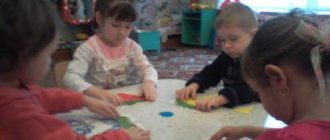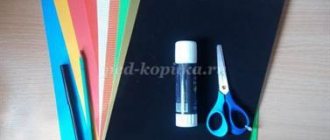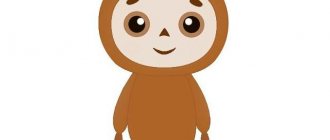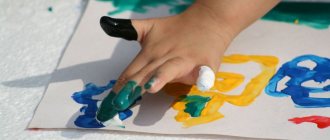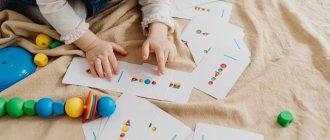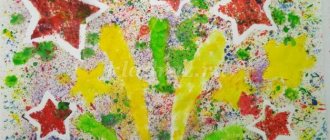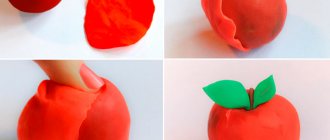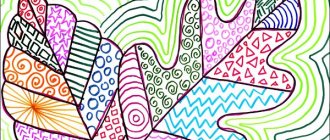Preview:
Topic: “Miracle - the brush dances.” Drawing.
Working with gouache paints.
Goals: - Continue to introduce the artistic material - “gouache”, and introduce the artistic tool - “brush”, new colors. Show how to work with them correctly.
— Development of creative imagination, imaginative perception, fantasy.
- good manners, neatness, careful attitude towards art supplies, evoke a positive emotional attitude towards the results of activities
Technique: Painting with a brush.
Materials and equipment:
Demo. Two tassels of different sizes in flirty skirts. Drawings by older children. Toy squirrel with a fluffy tail.
Razlatochny. A-4 paper, gouache 12 colors, jar of water, brushes, napkin
Preliminary work: examining paintings, pictures with artistic tools. Conversation about them. Reading a fairy tale about the “magic brush”.
Cheerful music sounds, so that your legs want to start dancing. Two tassels appear: one small, the other larger in flirty skirts.
Q. We are tassel sisters
We love to dance
And we came to your groups
We love to paint
And leave traces.
Extraordinary beauty (music removed)
(V. has 2 brushes in his hands, dancing and making smooth movements)
B. The brushes stop and look around
Q. We came to visit you. Oh, how many toys you have. Do you have any favorite toys? Yes, a doll, a ball, a hedgehog, etc.
Q. Would you like to draw with us today?
Q. Let's get to know our new friends better. what beautiful hairstyles they have. They are made from hairs that the squirrel gave from its tail. They have very fluffy tails. and shows the squirrel's tail). Feel how soft and fluffy we are.
(Touch each child’s palm with a dry brush)
V. kids, we are so soft, fluffy, thin. If you press the brush roughly, it will be very painful and our fibers will come out. You need to draw carefully, do not put pressure on the brush (show how to smoothly and softly draw lines, curls, make a spiral, point the brush in one direction or the other)
Q. Our miracle brushes also have a shiny rim by which you need to hold the brush. (Like this. Take the brushes, show it, look at it).
There is a wooden stick on which the headband is held. When you dip us in the paint, you only need to dip the tip of the brush so that the paint doesn't get into our eyes.
(Show B. How to dip a brush. How to rinse and blot the brush so that there is no excess, otherwise the paint will run)
Let's try. Take paints, this is gouache. You are already familiar with these colors. Let's remember them.
D. Red, blue, green, yellow, black, brown
Q. Look, there are still colors here. Move the leaves, take the big sister brush. She is so fast, she draws mountains, and the sun, and a river, and a clearing. Just don’t confuse the colors, rinse the brush with the sun and remove excess water with a napkin. Let's draw
B. A little sister is very neat. She loves to draw everything small, slowly: rays, pebbles, sand, a butterfly, grass. These are such friendly sisters, what a beautiful dance they danced. First one, then the other, they are always together.
Q. Are you guys friendly? Do you respect each other? Helping each other?
B. We draw. Don’t use too much paint, don’t get the rim dirty, otherwise our little sisters’ brushes will be offended by you. Be careful
B. After you have painted, you need to rinse the brush in water and blot it on a napkin. Now dip it in a different color. The brush waved its tail, the path became, waved again, the river flowed, and if you just touched the leaf, a dot became, if you pressed a little harder, a speck appeared. Truly miracle brushes.
(Children leave spots, stripes, dots all over the sheet, whatever they want, as they can and what they can do. Or maybe they will come up with a plot. Do not interfere in the drawing process under any circumstances. Let it be a creative work, this environment helps to master various brush techniques)
B. The squirrel watches you draw and she and yours are very pleased. And your favorite toys were watching you too. You made beautiful, colorful, bright drawings.
Exhibition of creative works.
Drawing. “The brush walks: top-top-top”
Tasks. Introduce children to new materials (paints, brushes). Teach the rules of using paints: carefully pick up paint on a brush, draw on a sheet of paper; hold the brush in your right hand. Encourage children to experiment with color, rhythmically apply strokes in different parts of a sheet of paper.
Materials. Red gouache paint, brushes No. 8-10, sheets of white landscape paper.
Preliminary work. Examination of illustrations with children, drawing by the teacher of the simplest shapes, lines, strokes on paper.
Contents of the lesson. The teacher reminds the children that at first they learned to draw with colored pencils. “And now,” she says, “let’s learn to paint. Look: the paint in the jar is red, how beautiful and bright it is. Ri-
you need to poke it with a brush (shows it to the children). The brush at the end of the stick is soft (the bristles of the brush are brushed across each child’s palm). Now I will show you how to draw. First, we dip the brush into the paint, squeeze out the excess paint on the edge of the jar and draw on paper (draw a wide line), we get a “path.” Then he places the brush flat on a sheet of paper: “Top-top-top - the brush walks,” makes circular movements with the brush: the brush “dances.” After this, the teacher draws a circle and a lot of sticks around, it turns out to be the sun. “This is such a wonderful brush, it can paint everything. Now, guys, take a brush in your right hand and try to paint on paper.”
The teacher gives each child a brush, shows how to hold it in the right hand, and offers to take some paint and paint on paper. During the drawing process, the teacher makes sure that the children do not stain their clothes and carefully apply the paint to the pile. Encourages the desire to experiment with paint, drawing in different parts of the sheet, painting its surface.
At the end of the lesson, he collects the brushes, lays out the drawings on a separate table and invites the children to examine them. Together with the children, he finds similarities with objects: “Here is the red sun, and this is a flower, bugs, paths, etc.” Encourages children's desire to name the images that appear. Children look at the work, the teacher asks them to find their drawing.
Actions with objects. “Assembling a pyramid”
Tasks. Learn to assemble a pyramid of 3-4 (5) rings of the same color, successively decreasing in size, develop finer differentiation when selecting objects in decreasing order, practice accurately placing the hole of the ring on the rod.
Materials. One-color pyramid of 3-4 (5) rings for each child.
Contents of the lesson. The teacher places the assembled pyramid in front of each child (the size of the rings decreases) and asks them to disassemble it: first put the lids in the middle of the table, then the rings.
“Show me the biggest ring!” - says the adult and offers to string it on a rod (shows how to do this on his pyramid, helps children who make mistakes). Then from
Of the remaining rings, the children again choose the largest one and string it onto the rod.
This is how the entire pyramid is assembled - from the largest to the smallest ring. The pyramid is closed with a lid and moved to the middle of the table. The teacher draws attention to the fact that the work is completed.
Then he suggests disassembling the pyramid and laying out all the rings in a row (from largest to smallest) and then stringing them sequentially onto the rod.
Speech. "You, little dog, don't bark"
Tasks. Involve children in communication. Enrich the vocabulary of understandable verbs and nouns denoting body parts. Develop speech hearing and articulatory apparatus in children. Create conditions for proactive statements.
1 Materials. Toys: dogs, ducks. Basin with water.
Contents of the lesson. The teacher sits the children in a semicircle in the play corner. Addresses them: “I’ll tell you a riddle about a dog:
You stroke it and it caresses you, You tease it and it bites you.
Invites the children to stand up and look for the dog (the toy is placed in a visible place in advance). If the children find several toy dogs, the teacher praises them.
An acquaintance scene is played out.
“Aw-aw! Hello guys! Let's get acquainted. My name is Filya. What’s your name?” - says the teacher. (The teacher brings the toy to individual children, encouraging them to say their name and stroke the toy.)
Next, the teacher turns to the children with a proposal: “The dog loves to be praised. Let's praise her. Fili's ears are erect. The tail is shaggy. (Invites the children to stroke their ears and tail.) Show me where the dog’s ears are? Where's the tail? (Brings the toy to individual children and encourages them to answer the question with action.) How does she use her voice? (Together with children: aw-aw!) What can a dog do?” (The teacher demonstrates the dog’s actions: barks, jumps, runs, lies, moves his tail. Encourages children to play
with a dog: jump, dance, clap.) The teacher turns to the dog: “You, little dog, don’t bark, don’t scare our ducks!”
- Let's see where our ducks are? - Surprisingly puts a bowl of water and ducks swimming in it on the table. Encourages one of the children to pick up the dog and say the words: “You, little dog, don’t bark, don’t scare our ducks!”
The dog is given to another child. They encourage you to bark like a dog. Repeat the words in chorus 3-4 times.
Toys are left for the free use of children, provoking initiative statements and emotional sounds.
Modeling. "Grains for the Birds"
Tasks. Evoke an emotional response in children, a desire to show care for the birds. Teach children to sculpt from plasticine, tearing small lumps from a whole piece, roll it out in the palms with circular movements of the hands; sculpt on oilcloth, use plasticine carefully, do not scatter it on the table. Develop fine motor skills of the fingers.
Preliminary work. Watching birds pecking grains while walking, looking at illustrations of birds, singing songs about birds.
Materials. A box of colored plasticine, oilcloth, a toy bird, hand wipes.
Contents of the lesson. The teacher draws the children's attention to changes in nature with the onset of cold weather, the birds also became cold, they need to be taken care of, fed with grains.
The teacher shows the children a toy bird: “Guys, a bird has flown to us,” says the teacher and adds emphatically:
A little bird flew to us. I’ll give some grains to the little bird.”
The teacher approaches each child and invites him to stroke the bird’s head and back: “This is the bird, it has a round head, beak, and tail. We make a lot of grains for the bird. To do this, you need to take a piece of plasticine and tear off small lumps, roll them in your palms.” The teacher shows the sculpting process and invites each child to make a lump and make a lot of grains.
The children begin to sculpt. The teacher helps those who find it difficult to choose colored lumps of plasticine and roll them out in their palms. During the sculpting process, he again repeats expressive words about the bird, thereby creating an emotional atmosphere in the lesson. Then he says: “The bird is very happy that the children made a lot of grains for her. Now the bird doesn’t have to be afraid of the cold. The children will take care of her and feed her delicious grains.”
At the end of the lesson, the teacher asks the children to repeat with her:
A little bird flew to us. I will give some grains to the little bird.
And each child brings the molded grains and puts them on a plate so that the bird can peck them. After modeling, children wipe their hands with a napkin.
Then the teacher invites the children to play, “fly” like birds, sit down, and tap their fingers on the floor (as if they were pecking at grains). The game is repeated 2-3 times.
Organization of children's games
The teacher continues to introduce children to the game based on plots dictated by the content of the lessons and the children’s personal experiences. The Cockerel toy is introduced into the game, the children examine it, stroke it, listen to it “sing” (the teacher crows for it), and try to imitate its singing. The teacher invites the children to play as if they were cockerels, peck at imaginary grains, and flap their wings. Those who wish can play with toy cockerels, hens, and chicks. The teacher actively supports in de-
He is in an emotional mood, participates in the game, sings songs and nursery rhymes. At the site, Cockerel is fed not only grains, he can also bake a little cake; he can crow by climbing onto a “fence” - a bench, etc. Other toys that have already been taken for a walk can show him a slide, a sandbox, trees, and play together. Children should be encouraged to communicate: “Sasha, show Cockerel the sandbox! Masha, let your doll bake him a pie!” etc.
You can also play similar games in a group. The teacher invites one or more children to “visit”; in addition to them, the guests can be dolls and animals. The table is set in advance, and when the children join the game, it turns out that some cutlery, cups, spoons were missing for someone. The teacher asks the children to help, bring a spoon, pour a pretend cup of tea, etc. At the same time, the level of development of children’s play imagination is taken into account: one can only use real objects at this age, another already knows conditional actions, and some even speak words.
Special situations are introduced into the game: Bear spilled tea, you need to wipe the table; Masha doll dropped her spoon, she needs to be picked up and washed; the kettle has cooled down, it needs to be heated up again (turn it on or “warm” it on the stove). In joint play, children who cannot speak and have difficulty communicating begin to imitate the actions of “skilled” children; those who are still afraid of their peers feel more relaxed when the teacher plays with them.
SEPTEMBER. WEEK 4 Work planning
Direction of pedagogical work. In the process of observations, children will continue to become emotionally familiar with autumn phenomena (leaf fall, autumn leaves) and enrich their impressions by painting, listening to songs, and imaginative movements in physical education classes. Particular attention will be paid to maintaining interest in kindergarten and an individual approach to children who are having difficulty going through the period of adaptation. Work will continue on the formation of cultural and hygienic skills, the development of object-tool actions, plot construction, and the improvement of children’s articulatory apparatus.
